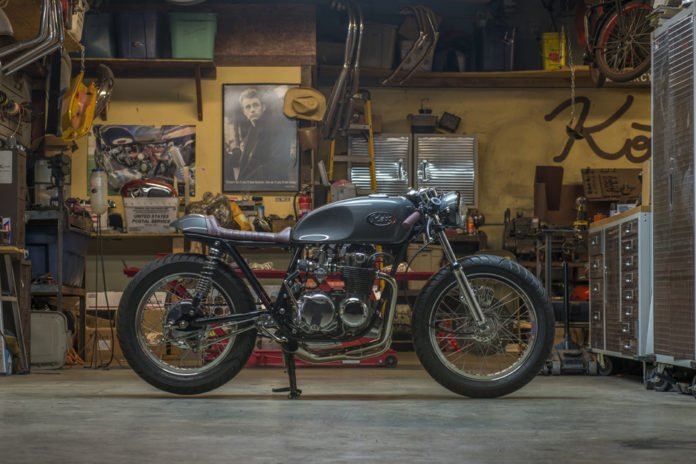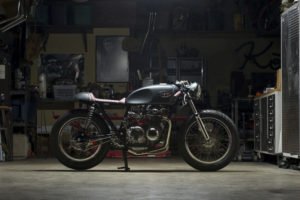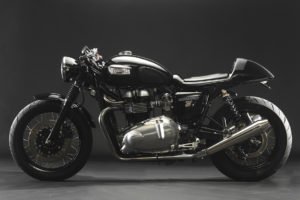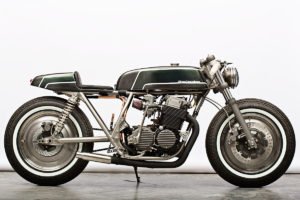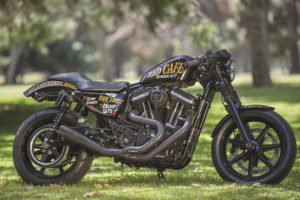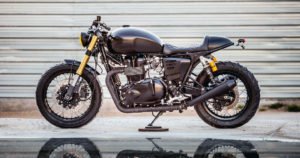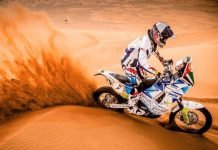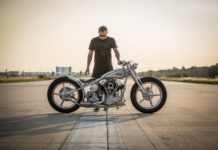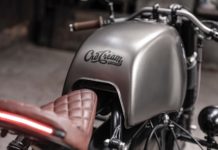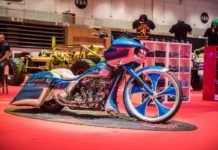Any Cafe Racer rider will insist that there is no specific “right” way to build a cafe bike. Your bike is a reflection of who you are and your own personal styling. You can build it however you want. With this in in mind, functionality, style and innovation are essential. The way you style your build can make a bike a “must have” or a “dust collector”.
In essence, the bike is a canvas and each builder the artist; manipulating metal, lines and exhaust note to completely enrich their masterpiece.
Historically we all know that cafe racers were essentially stripped down motorcycles, as function and speed were the main goals. Nowadays; with these elements mastered, we are seeing even more unique takes on these cafe racer creations.
Whilst some builders are loyalists to iconic stylings of the past, using only original and year specific parts and rejecting any modernity, others make use of how far motorcycle technology has come.
Check out my list of my top 5 influential builders below, who are truly masters of their art.
DUSTIN KOTT
Kott Motorcycles is an independently-owned company based in the Los Angeles area. Dustin Kott, (founder of Kott Motorcycles) is skilled at fabrication and design of vintage motorcycles, namely bikes from the 1970’s like the Honda CB series.
The first time I saw Dustin was on TV, I saw this stylish dude wonder around his workshop, rolling around an old Honda and discussing his passion for bringing these bikes to life. His clean lines, bike stance and styling made my jaw drop.
Dustin says: “My love of motorcycles goes back as far as I can remember. I have memories of sitting in front of my dad on a motorcycle as early as two years old and I cannot remember ever wanting to do anything else with my life.”
It is clear that Dustin Kott has found the secret of simplifying the essence of these machines and bringing functionality back into antiquated machines. We see that Dustin continually builds functional street machines that have cafe racer inspiration by redefining all aspects from front to back, bottom to top to create a more ergonomic and elegant machine all the while embracing the original vintage soul of these bikes and this is the primary purpose of his shop. This is achieved by bringing a new appeal both mechanically as well as through the enhancement of performance elements subsequently breathing new life into vintage motorcycles.
Dustin is also famous for building a very unique triumph café racer for actor Ryan Reynolds. Built from a 2014-model, fuel-injected Triumph Thruxton this bike was designed “to reveal exactly what lay dormant within the modern Thruxton’s unrealized potential.” Whilst keeping the rider’s (Ryan Reynolds) influences in mind.
DIME CITY CYCLES
These are the builders who probably influenced me the most. When I moved overseas and finally got my hands on my dream bike, a Triumph Bonnie, I looked around for inspiration. Dime City were ahead of the game on modifying triumphs and had produced a Triumph Cafe Racer with their own custom fabricated parts! Their styling and innovation motivated guys like me to do it.
They began in 2009 with a Honda CB450, one small garage, and a few borrowed wrenches. Since those humble beginnings Dime City Cycles have grown considerably. They now have a warehouse filled with the very latest in parts and accessories and send their custom parts and builds globally.
They’re most iconic build to-date in my opinion is the famous “Brass Cafe”. Sporting hand-tooled, solid brass accents and plating, it will follows all the classic cafe lines while forging a path for new ideas and inspiration to be explored by the next generation Cafe Racer builder. Leaving nothing unturned, all the trimmings will be present making any Tonner more than pleased with the final product. In an effort to pay homage to classic DIY Cafe Racer culture, as much of the original 1968 donor bike was used as possible while modifying the remaining elements for a hand-hewn and “factory-like” look and feel.
Dime City’s desire with the Brass Cafe was to produce what could have been a factory concept bike from the 60’s were Honda tailoring their efforts towards rich tones and style rooted in Cafe Racer culture. The tank for example, is an original item that was cut on both sides and the top with new hand-made pieces being grafted in creating a look similar to that of the stock Honda with a little Dime City flair.
WRENCHMONKEES
Their style is unmistakable; it is the motorcycle manifestation of Scandinavian minimalism – “monochrome, masculine and understated”. WrenchMonkees was founded in a Copenhagen basement in 2008, with an intention to redesign and build custom bikes that could stand-out from the custom scene at that time. Whilst many builders rely on flashy aspects, the Danes are known for their reserved style. The bikes have clear lines and tough surfaces. Adding to the Monkees iconic status, they’ve been around since the beginning of the new wave of custom bikes.
As quoted by them “The best builders show their character in their bikes” and this is evident in many of their builds, including the MONKEE #11.
The MONKEE #11, nicknamed the “Gorilla Punch” started life as a Honda CB750, the WrenchMonkees stripped it back to nothing and built it into their own custom café racer/work of art. The bike was finished in late 2008 and immediately went on display at the Danish Museum of Art and Design in Copenhagen, after which it was displayed by Rojo Artspace in Barcelona.
Gorilla Punch was clearly built to be ridden and not just looked at, it has a stack of features you won’t find on many show bikes, things like suspension front and rear, disc brakes front and rear, lights, blinkers and even a muffler (albeit a tiny one). The asking price for the bike was $30,000 USD.
ROLAND SANDS
Roland Sands is an American motorcycle racer and designer and began his life with the upbringing and diverse experience in the motorcycle industry. His first motorcycle was a RM50 dirt bike, given to him on his 5th birthday, to which, after just minutes of riding, he broke a bone, but fell in love with it anyway. He literally grew up in the Performance Machine shop, and started working there at age 14 sweeping floors. Quickly moving up to assembly, sanding polishing, wheel designing, eventually working his way as Director of R&D and Design at Performance Machine. In 2005, after the tremendous success Sands found on Discovery Channel’s Biker Build-Off vs. Arlen Ness, Sands founded Roland Sands Design. RSD designs concept motorcycle parts and accessories and builds custom motorcycles. RSD works with major motorcycle manufacturers to design concept and prototype motorcycles and promote benchmark product in the motorcycle industry and beyond.
Roland Sands draws on influences from the sport bike and chopper worlds. He has since played a pivotal role in popularizing high performance custom bikes to the masses. My favorite build from him would be the Technics Sporty built from a Hrley Davidson 883 Iron.
For this build Roland Sands took inspiration from the DH1-1200 Headphones as well as the classic SL-1200MK2 Professional turntables. They tried to keep the details subtle enough to stand alone as well designed elements while not being too obviously related to the Technics DJ equipment. The most obvious connection to the Technics product are the wheels which went through several design iterations. They were extremely happy to reach a well-proportioned mix of “theme” and design with this project. The remaining inspiration was drawn from the classic silver and black, satin and gloss finishes that have been a part of the Technics brand and style.
MACCO MOTORS
Founded in 2011, Macco Motors was founded in the Spanish city of Cadiz, by Jose and Tito.
They wanted to build a place where bike dreams could come true and were heavily influenced by retro aesthetics. “When it comes to building a new bike, we try to combine style and performance, and that each new creation is unique and exclusive” they have stated. Known for their nitty-gritty attention to details, they look for the harmony in the curves and the forms, respecting the spirit of the original motorcycle. Macco Motors has got a lot of attention recently and have some very beautiful creations on display at The Bike Shed in London.
Jose & Tito sourced a 5000km Thruxton from 2007, decided on the name ‘Lady Speed’ and got to work stripping-down the Hinckley brute. Many Macco projects end up as Street Scramblers thanks to the popularity of their early bikes but Jarl’s build would be refreshing change. An in-house tail section was made in fiberglass with a pop-out diamond stitched saddle, all mounted to a looped and re-fabricated sub-frame. The R&D has been carried out now which should pay dividends for next time. Whilst making a mess with sticky resin the guys formed mesh-grilled side panels.
Behind the panels; a small battery box can be found in place of the airbox, with all of the electrics repositioned in a neater, tighter space. K&N filters on re-jetted carbs add a modicum of performance and depth to the overall sound and a brace of reverse megaphones deal with the bass tones.
Jose & Tito’s formula works well and their customers keep coming back.


